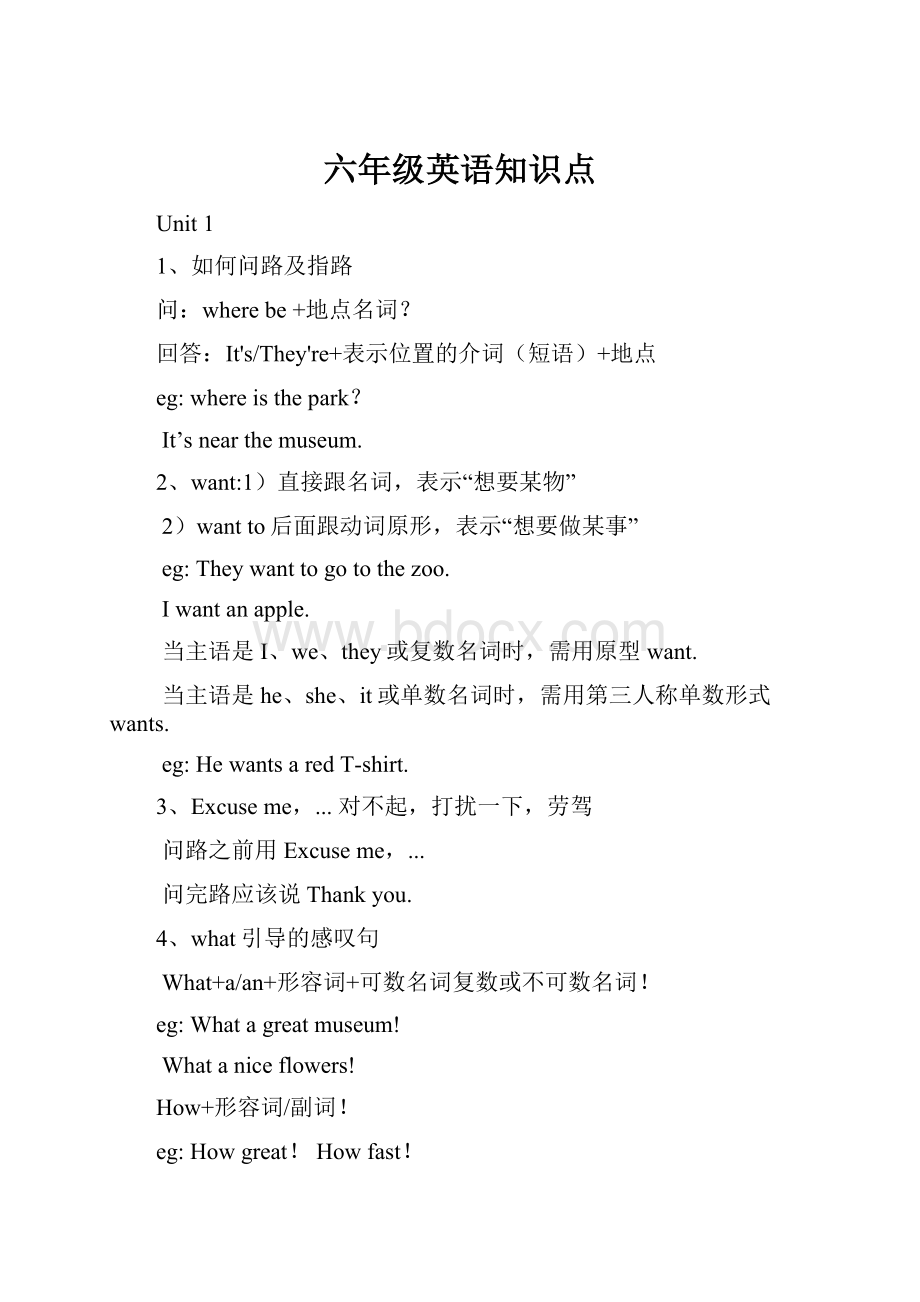六年级英语知识点.docx
《六年级英语知识点.docx》由会员分享,可在线阅读,更多相关《六年级英语知识点.docx(15页珍藏版)》请在冰豆网上搜索。

六年级英语知识点
Unit1
1、如何问路及指路
问:
wherebe+地点名词?
回答:
It's/They're+表示位置的介词(短语)+地点
eg:
whereisthepark?
It’snearthemuseum.
2、want:
1)直接跟名词,表示“想要某物”
2)wantto后面跟动词原形,表示“想要做某事”
eg:
Theywanttogotothezoo.
Iwantanapple.
当主语是I、we、they或复数名词时,需用原型want.
当主语是he、she、it或单数名词时,需用第三人称单数形式wants.
eg:
HewantsaredT-shirt.
3、Excuseme,...对不起,打扰一下,劳驾
问路之前用Excuseme,...
问完路应该说Thankyou.
4、what引导的感叹句
What+a/an+形容词+可数名词复数或不可数名词!
eg:
Whatagreatmuseum!
Whataniceflowers!
How+形容词/副词!
eg:
Howgreat!
Howfast!
一个单词或短语组成的感叹句!
eg:
Goodidea!
Wonderful!
Thankgoodness!
(谢天谢地!
)
5、Interesting:
“主动”形容词,用来形容物或人本身很有趣。
Interested:
“被动”形容词,表示“对......感兴趣”
beinterestedin....
6、China-----ChineseAmerica----American
Australia------AustralianCanada-----Canadian
Japan------Japanese
7、Howcanwegetthere?
用于问,How引导的特殊疑问句。
How意为“怎样”用来询问做事情的方式,位于句首,引导特殊疑问句。
Can是情态动词,意为“能,能够”后跟动词原形。
getto+地点名词/get+地点副词表示“到达某地”
地点副词:
there、here、home
常用句型:
HowcanI/weget(to)....?
我们怎么到.......?
eg:
HowcanIgetthere?
HowcanIgettothebookstore?
拓展:
1)whereis+地点名词?
(......在哪儿?
)
eg:
whereisthehospital?
2)whichisthewayto+地点名词?
(哪条路是去........的?
)
eg:
whichisthewaytothehospital?
3)Canyoutellmethewayto+地点名词?
(你能告诉我去......的路吗?
)
eg:
Canyoutellmethewaytothehospital?
8、ontheleft/right在左边/右边
Turnleft/right左转/右转(turntotheleft/right)
Turnleft/rightat+地点在某地向左转/右转
eg:
Turnleftatthecinema.
Turnrightatthepostoffice.
Turntotheleftatthehospital.
9、指路的常用句型:
Turnleft/rightat......在......左转/右转Gostraight.直行
10、help+sb.意为“帮助某人”
help+sb.do/todosth.意为“帮助某人做某事”
eg:
Let’shelpthelittlegirl.
Canyoutellme(to)learnEnglish?
help+sb.+with+名词.意为“在某事上帮助某人”
eg:
IwanttohelpTianwithhermaths.
10、infrontof在....前面(外部)
eg:
Therearetwobigtressinfrontofmyhouse.我家门前有两棵大树。
Inthefrontof在...前面(内部)
eg:
Lookattheblackboardinthefrontofourclassroom.看我们教室前面的黑板。
写作提升:
1)审题,抓取关键词。
既然是指路,一定要看清目的地。
2)在头脑中迅速画出简易地图,规划好前往路线。
3)知识储备:
常见的地点名:
park、zoo、cinema、museum、bookstore、hospital、restaurant、postoffice
常用的指路词组:
gostraight、turnleft/rightat....crossing、trafficlights
常用的表示方位的词组:
infrontof、nextto、behind、near
4)连词成句,连句成篇。
衔接词:
first、then、last等
例文:
TodayisSunday.Iwantgotocinemawithmyfriends.Thecinemaisnotfarfrommyhome.HowcanIgetthere?
Firstgostraightandturnrightatthepark.Thenturnleftatthefirstcrossing.Icanseethecinemaonmyright.It’snexttothepostoffice.
Unit2
交通方方式和交通规则
1、Howdoyoucometoschool?
你怎么来学校的?
问:
Howdoyoucome/go(to)+地点,用来询问对方来某地或去某地的出行方式。
答:
I/Wecome/go(to)+地点+表示出行方式的介词短语。
eg:
Howdoyougotothezoo?
Igotoonfoot.
come/go后面接的是地点名词时,需用“to+地点名词”,后面接副词home、here、there等词时,要省略掉介词to,表示“来,去......”
eg:
Howdowegohome?
2、频度副词:
在句子中一般位于实意动词之前,be动词、情态动词、助动词之后。
Always总是(百分之百发生)
Usually通常,一般(百分之八十发生)
Often经常(百分之六十发生)
Sometimes有时(百分之四十发生)
Never从不(不会发生,与always相反)
eg:
Wealwaysstayathome.
Peterisneverlateforschool.
Sometimes,wegotothebookstoreonfoot.
3、有关交通方式的词组
onfoot、byplane、airplane(飞机)、attheairplane(在机场)、bytaxi、takeataxi、byship(乘大船)、byboat(乘小船)、bysubway、underground(地铁)、bytrain、trainstation(火车站)、bybike、bysled、byferry
4、taketheNo.57bus.乘57路公交车
Take是动词,可以表示“乘坐”,“takea/the+交通工具”来表达交通方式
takeabusto+某地=goto+某地+bybus
rideabiketo+某地=goto+某地+bybike
交通工具前不加任何冠词
5、must情态动词,后接动词原形
主语+must+动词原形+其他
6、Don’tgoattheredlight.别闯红灯。
Don’t引导的否定祈使句
Don’t+动词原形+.....意为“不要做某事”,用于命令、请求对方或警告对方不要做某事。
祈使句:
1)动词原形+其他Openthedoor.
2)Let+人+动词原形+其他Let’sgohomenow.
3)No+名词或动词的-ing形式Noswimming!
Nosmoking!
7、payattentionto.....注意
eg:
Weshouldpayattentiontoourlistening.
8、trafficlights交通信号灯slowdown慢下来
Trafficrules交通规则fast快的Stopv.停下;n.车站
9、Slowdownandstopatayellowlight.黄灯时减速并停一停
Stopandwaitataredlight.红灯时停下来等一等
Goatagreenlight.绿灯行
10、why引导的特殊疑问句,一般用because来回答
eg:
whyareyousosad?
BecauseIlostmynewbook.
Becauseof“因为”介词短语,后面可接名词、代词或动名词。
写作提升:
1)审题,抓住关键词(去学校,交通方式)
2)罗列重要信息(介绍自己家离学校的远近,去学校的一些交通方式)
3)知识储备:
常用的频度副词:
Always、Usually、Often、Sometimes
常见的交通方式:
onfoot、byplane、airplane(飞机)、attheairplane(在机场)、bytaxi、takeataxi、byship(乘大船)、byboat(乘小船)、bysubway、underground(地铁)、bytrain、trainstation(火车站)、bybike、
常用句型:
Usually/SometimesIgotoschool......
Ioftengotoschool.....
4)连词成句,连句成篇
例文:
I’mastudent.Iusuallygotoschoolonfoot.Imustpayattentiontothetrafficlights.IcangoatagreenlightandImuststopandwaitataredlight.Beforecrossingtheroad,Ishouldlookrightandleftfirst,andIcancrosstheroad.
Unit3周末活动计划
1、Whatareyougoingtodotomorrow?
明天你打算做什么?
Begoingto+动词原形,常用来表示按计划或安排要发生的动作,有时也可以表示根据目前情况推测将要发生的动作,意为“打算,将要”,begoingto结构的时间状语必须是将来的时间,如:
tomorrow、tonight、nextto、thisafternoon、thisevening等
What引导的begoingto结构特殊疑问句
What+be动词+主语+goingto+动词原形+时间/地点?
eg:
whatareyougoingtodothisafternoon?
Whatisgoingtodointhepark?
WhatamIgoingtodotomorrow?
我明天做什么?
Begoingto的陈述句:
主语+be动词+goingto+动词原形+其他
eg:
I’mgoingtoplayfootballwhitWangBin?
Wearegoingtotakeatripnextweekend.
2、Have啊goodtime!
玩的开心!
其他的几种表达方式:
Haveanicetime!
Haveagreattime!
Havefun!
Enjoyoneself!
3、haveto“不得不做,必须”后面接动词原形,表示迫于某种限制条件或客观需要不得不做的事。
eg:
I’slate,Ihavetohomenow.
4、takeatrip、gotothesupermarket、at/inasupermarket在超市
Thisafternoon、lastweek、nextweek、nextmouth、nextyear、lastmouth
5、onhiswayhome在他回家的路上
His可用my、your、our、her、its、their代替,也可以用名词所有格代替,Jack’s、Lily’s等
6、Whereareyougoing?
你们打算去哪儿?
用来询问某人打算或计划去哪儿,基本句型为:
where+be动词+主语+going(+将来时间)?
eg:
whereareyourparentsgoingtomorrow?
WhereisshegoingonSunday?
Where是副词所以省略去了begoingto中的to
7、whenareyougoing?
你们打算什么时候去?
When+be动词+主语+going(to+地点/dosth.)某人打算何时做某事
询问活动用what
Whatareyougoingtodotonight?
询问时间用when
Whenareyougoingtoswim?
询问地点用where
Whereareyougoingtoplay?
询问方式用how
HowaretheygoingtoBeijing?
8、WhynotgoonTuesday?
为什么不在星期二去呢?
Whynot+动词原形?
意为“为什么不.....呢”用来询问原因或用反问的语气提出建议。
其同义句为:
whydon’tyou+动词原形?
意为“为什么不......呢”
eg:
whynotgotherebybus?
=whydon’tyougotherebybus?
9、halfprice、halfanhour半小时、halfpastsix六点半、marketprice市价buyapostcard买明信片sendapostcard寄明信片
10、Hereyouare!
给你!
Heretheyare!
他们在这儿!
Hereisit!
他在这儿!
Be动词的位置:
1)如果句子的主语是代词,be动词要置主语之后
2)如果句子的主语是名词,则要将be动词置于主语之前
eg:
Hereareyourpencils.这些是你的铅笔.
11、SpringFestival春节visitrelativesandfriends走亲访友
LanternFestival元宵节enjoybeautifulandlanterns赏花灯
DragonBoatFestival端午节watchthedragonboatrace看龙舟Mid-AutumnFestival中秋节eatmooncakes吃月饼makemooncakes做月饼
Gettogether聚会writeapoem写一首诗readapoem读一首诗
12、tell讲述,告诉tellsb.todosth.告诉某人做某事
eg:
Tellthekidstobequiet,please.
tellsb.sth.=tellsb.aboutsth.告诉某人某事eg:
Tellmeyourphonenumber.
写作提升:
日记的形式写周某计划
1)构思。
看到题目是周某计划,我们可以抓住人物、时间、地点、事件等关键点来介绍。
2)确定词语:
时间单词:
Saturday、Sunday、tomorrow、tonight、nextto、thisafternoon、thisevening
活动单词及短语:
takeatrip、gotothesupermarket、gettogether、redbook、whatTV、playfootball、visitmygrandparents........
句型:
主语+begoingto+动词原形+将来时的时间
注意:
周某计划,属于将要发生的事,所以全文用将来时,主谓一致性,单复数变化,句首单词首字母大写及标点的使用。
3)通读检查
例文:
Myfamilyisgoingtohaveabusyweekend.OnSaturday,wearegoingtothesupermarket.ThenI’mgoingtothebookstoretoreadsomebooks.OnSunday,mydadisgoingtocleantheroom.Mymumisgoingtowashtheclothes.I’mgoingtodomyhomework.
Unit4我有一笔友
1、WhatarePeter’shobbies?
hobbies,hobby的复数,同义词:
interest
询问某人爱好的句型:
what+be动词+........’shobby/hobbies?
be动词根据句中的hobby的单复数形式来确定,’s是形容词性物主代词或名词所有格。
回答:
主语+like/likes+名词/动词-ing形式。
eg:
whatareyourhobbies?
Ilikereadingbooksandlisteningtomusic.
同义句:
whatdo/does+某人+like?
某人喜欢什么?
eg:
whatdoyoulike?
whatdoesMarylike?
2、1)like+名词,意为“喜欢某物”eg:
Ilikestorybook.
2)like+动词-ing形式,意为“喜欢做某事”,表示经常性或习惯性爱好
3)Like+to+动词原形,意为“喜欢做某事”,侧重于一次性的行为或动作。
eg:
IliketovisittheGreatWall.Shelikes(draw)pictures.
3、also和too
also也用于肯定句中,在句中的位置放置于实义动词之前
Ialsolikeplayingthepiano.
too也用于肯定句中,多至于句末,前面常用逗号隔开。
Ihavearuler,too.
4、teach的用法:
teach+sb.(宾格)+sth.意为“教某人某事”
eg:
MikeisgoingtoteachmeEnglishthisevening.
Teachsb.Todosth.意为“教某人做某事”
eg:
Myfatherteachesmetomakekites.
双宾语动词:
give,buy,send,show
5、Goodidea!
Haveaidea有一个好主意
6、动词-ing形式的变化
1)一般在词尾直接加-ing:
sing--singingdo--doingread--readingplay--playing
2)以不发音的e结尾的去掉e,再加-ing:
dance-dancingwrite-writing
3)以重读闭音节结尾并且末尾只有一个辅音结尾的,应该双写这个辅音字母再加-ing:
run-runningswim-swimmingstop-stopping
7、play的用法:
1)play+球类/棋类playbasketball、playfootball
3)play+the+乐器playthepiano、playtheerhu
4)play+with+其他playwithsnow
8、一般现在时的一般疑问句:
问:
Do/Does+主语+动词原形+其他?
回答:
肯定:
Yes,主语(人称代词)+do/does
否定:
No,主语(人称代词)+don’t/doesn’t.
eg:
Doesyourmothergotoworkbybus?
Yes,shedoes./No,doesn’t.
9、第三人称单数:
1)一般在词尾加-s:
make--makeslove--lovesplay--plays
2)以s、x、ch、sh结尾的,在词尾加-es:
teach--teacheswatch--watches
3)以辅音字母+y结尾的,改y为i,再加-es:
study-studies
4)以o结尾的,加-es:
do-doesgo-goes
Study的近义词learn,名词:
hiking、shopping、jogging(慢跑)
10、shallwedance?
我们去跳舞,好吗?
Shall,表示征求意见,用于第一、三人称,意为“......好吗”eg:
shallIopenthewindow?
Share,动词,分享:
share+名词,意为“分享某物”
sharesth.withsb.意为“与某人分享某物”
写作提升
写作书信,格式上必须由三要素
1)称呼
2)正文。
此封信的内容,主要围绕什么来写,应包括以下:
首先要说明你写信的目的,其次介绍自己的个人信息,最后提出你对笔友的要求。
3)落款。
范文:
Dearfriends,
Ianlookingforapenpal,Ihavemanyhobbies.Ioftengohikingontheweekend.IcancookChinesefood.DoyoulikeChinesefood?
IwanttostudyEnglish.Canyouhelpme?
Writetomesoon.
Yours
你的姓名
Unit5人物职业和生活情况CareerDay职业体验日
1、Whatdoeshedo?
问的是单个人,所以用单三
问:
what+does+主语(第三人称单数)+do?
答:
He/sheisa/an+职业单词其中does是助动词,显示主语的人称和数后面的动词do是实意动词,表示“做”的意思,用动词原形。
eg:
whatdoesyourmotherdo?
Sheisanurse.
What